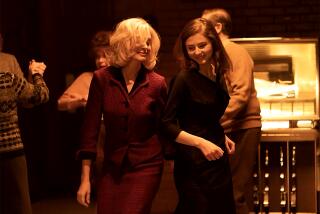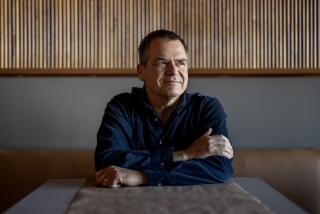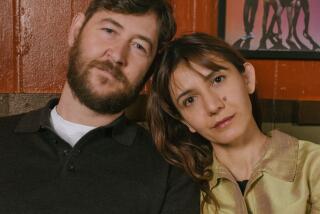A Real ‘Farewell to Arms’
- Share via
Producer Dimitri Villard was sitting in his small Beverly Hills office, fishing in a briefcase crammed with script revisions and production notes. Finally, he pulled out a color snapshot. “Here,” he said, handing it to a visitor.
The picture showed Villard beaming as he sat on a sofa beside an elderly man who was wearing a blue blazer and loosely knotted red tie.
“That was just last Christmas,” he continued, which meant that the photo had been taken several weeks before the older man--Dimitri’s father, Henry S. Villard--had died at 95. “He doesn’t look too bad considering his age, does he?”
Villard has more than sentimental reasons to tote around this last Christmas photo. His father had inspired--and is even a character in--”In Love and War,” the $40-million film that Villard is producing in Europe this summer starring Sandra Bullock and Chris O’Donnell as star-crossed lovers in war-torn Italy. New Line Cinema hopes to release the movie, billed as a “Dr. Zhivago”-type epic, around Christmas.
The project stemmed from the elder Villard’s experiences during World War I, when he befriended a handsome, cocky 19-year-old ambulance driver named Ernest Hemingway. More than 70 years later, Henry Villard co-wrote a scholarly memoir about the romance between Hemingway and nurse Agnes von Kurowsky. The younger Villard, a former B-movie producer who once worked with Roger Corman, then embarked on a seven-year odyssey to bring the story to the screen.
“When the book came out, what struck me was that this tragic love story was one that had tremendous appeal,” Dimitri Villard said on the eve of his departure for Europe. “What happened was so real, so human--it was something that almost everyone can identify with. When I pitched the story [to studios], I would always not reveal it was about Ernest Hemingway until the very end. I found that people responded to the story itself.”
Of course, because the movie concerns a real-life incident generally believed to have formed the basis for Hemingway’s classic novel “A Farewell to Arms,” it is bound to get more attention than the typical movie romance. But Villard cautioned that moviegoers should not expect a totally faithful version of events. This is Hollywood, after all.
“We took some dramatic liberty” with the script, he acknowledged.
Yet Villard and his collaborators believe that the movie will nevertheless depict a crucial period in Hemingway’s progress toward household-name status.
“We know that Hemingway’s relationship with Agnes affected the way he felt about women,” Villard said. “It probably had an important influence on his writing. Agnes was certainly the person on whom the character of Catherine Barkley was based in ‘A Farewell to Arms.’ I don’t think [Hemingway] ever forgot her.”
“It was the first time [Hemingway] had fallen in love,” O’Donnell, who plays young Hemingway, said by phone during a break in shooting. “It made him grow up. He lost his innocence with that relationship.”
“He unquestionably adored Agnes, she was the love of his life,” said Sir Richard Attenborough, the director of “In Love and War,” during a break from shooting in Italy. “Who’s to say what he might have written had they not broken up? All one knows is that all that aggression apparent in everything he writes--the frustration, disappointment and sense of betrayal--was following Agnes’ decision to write her ‘Dear John’ letter.”
While purists may scorn the film’s dramatic liberties, the filmmakers have relied on a treasure-trove of historical data uncovered by Henry Villard and Hemingway scholar James Nagel. Among the primary sources is the wartime diary of Von Kurowsky, played in the film by Bullock.
“Now, Ernest Hemingway has a case on me, or thinks he has,” Von Kurowsky wrote in her diary on Aug. 25, 1918. She was a 26-year-old nurse at the American Red Cross Hospital in Milan, where Hemingway was shipped after being wounded on the northern Italian front. “He is a dear boy & so cute about it.”
The object of young Hemingway’s desire was bright, witty, attractive and, by her own admission, extremely flirtatious.
“It was easy to see why Hemingway should fall as he did for Agnes,” Henry Villard would later remember. “She had a sparkle the [other nurses] didn’t possess.”
The pair began a seven-month courtship, much of it conducted long distance because of Von Kurowsky’s nursing assignments elsewhere in Italy. In January 1919, Hemingway shipped back to the U.S., evidently assuming that he and Von Kurowsky would get married when she returned home.
But a couple of months later, she broke off the affair with this letter: “I was trying to convince myself it was a real love affair, because we always seemed to disagree, then arguments always wore me out so that I finally gave in to keep you from doing something desperate.” After time apart, she wrote, “I know I am still very fond of you, but it is more as a mother than as a sweetheart.”
Was it ever a “real love affair” in the sexual sense? Scholars are dubious. The rooms in the Red Cross hospital all opened onto a common area and the nursing staff frequently shuttled in and out, yielding very little privacy. A supervisor closely monitored each nurse’s schedule and whereabouts.
On the other hand, secrets can be surprisingly easy to keep. Henry Villard, who occupied the room next to Hemingway’s, admitted that he knew nothing about a romance of any kind between Hemingway and Von Kurowsky until years after the war.
“The film does not dwell on this aspect of their relationship,” said Dimitri Villard. But “In Love and War,” according to an early version of the script, clearly wants viewers to understand that its two protagonists slept together. There’s even a love scene or two.
If that’s “dramatic liberty,” Villard may be entitled to it. He began working on a movie version shortly after his father and Nagel published “Hemingway in Love and War” in 1989.
In his late 40s--he declines to give his exact age--Villard is reveling in the biggest coup of his career. Until now, his main claim to fame was as one of the producers of “Once Bitten,” a 1985 vampire comedy starring Lauren Hutton and a then-unknown Jim Carrey. Throughout the ‘80s, he and a partner produced a series of low-budget, direct-to-video titles such as the sci-fi “Time Walker” (“Nothing could stop him--not even time!”).
The elder Villard had been a career diplomat, but in later life he carved out a second career as a writer. While Dimitri instantly recognized the movie potential of his father’s memoir, he also knew that the project would be a tough sell in Hollywood.
“In 1990, epic, period, tragic love stories were not what the studios were looking for,” he said. “So I went into partnership with an Italian production company to develop the project. And we went through several drafts of a script. But it was clear they and I were not seeing eye to eye on the direction.” Essentially, Villard said, the production company wanted a story closer to “A Farewell to Arms.”
So Villard set out on his own. He pitched the story to production companies owned by Michelle Pfeiffer and Julia Roberts, but both stars were busy with other films, he said.
At an industry event, Villard happened to mention the project to Sara Risher, an old friend and chairman of production at New Line Productions. Risher was intrigued.
“It was the true story of ‘A Farewell to Arms,’ ” she said. “I loved the way it was told through [Agnes’] eyes. I liked the idea that she was older and that he was forming himself to become Hemingway. . . . It immediately smacked of epic romance, of ‘Dr. Zhivago.’ ”
New Line optioned the book, and screenwriter Allan Scott wrote a first draft (later versions incorporated work by Clancy Sigal, Anna Hamilton Phelan and Robert Benton). O’Donnell and Attenborough committed soon after, with Bullock coming on board later. (Through her representatives, Bullock did not respond to repeated interview requests.) Villard even had the unusual opportunity to cast a young actor--Mackenzie Astin, son of John Astin and Patty Duke--in the role of his father.
The producer feels lucky to have gotten to this point.
“Someone once told me that producing a picture is like trying to make a bowl of Jell-O without the bowl,” he said, his hands groping the air.
Attenborough and others have taken pains to distance “In Love and War” from “A Farewell to Arms,” noting that in the novel, British nurse Catherine Barkley and her lover, Lt. Fredric Henry, escape to Switzerland, where Catherine dies in childbirth.
Indeed, the novel, published in 1929, is likely a seamless amalgam of experience and imagination. Scholars have suggested, for example, that Catherine is probably not a mere stand-in for Von Kurowsky but rather a composite of her and other women Hemingway knew, including the second of his four wives, Pauline Pfeiffer; British nurse Elsie Jessup; and F. Scott Fitzgerald’s wife, Zelda.
While it may be true that the breakup with Von Kurowsky devastated Hemingway, biographers warn that it would be risky to give the incident too much weight in assessing his writing. Hemingway was probably affected far more deeply by his unhappy home life. His father, Clarence, was a severe depressive who committed suicide in 1928. Ernest and siblings Leicester and Ursula would eventually follow his lead.
“We would easily call [the Hemingway family] dysfunctional,” says Rose Marie Burwell, a Hemingway scholar and professor of English at Northern Illinois University.
Of course, the creators of “In Love and War” have good reason for emphasizing the affair as central to Hemingway’s art. The screenplay places Henry Villard and Von Kurowsky at the novelist’s 1961 funeral when neither, in fact, was there. It also suggests a failed attempt by Von Kurowsky at a postwar reconciliation.
But, in fact, Von Kurowsky, who died in 1984, never saw Hemingway again after he left Italy. Once she and her second husband visited Cuba, but she refused to look up Hemingway because she heard that he drank heavily. She resented the assumption that she and Catherine Barkley were one and the same and also vehemently denied that she and Hemingway had ever slept together. “Let’s get it straight--please,” she told Henry Villard many years later. “I wasn’t that kind of girl.”
Were she alive, the depiction in the film would likely please Von Kurowsky even less. But, as Burwell notes: “You have to create a narrative for a film. . . . It’s like John Barth says, ‘The story of your life is not your life, it’s your story.’ ”
For Villard pere and fils, at least, the story has a happy ending. Shortly after Dimitri clinched the deal for “In Love and War” last December, he and his father joined Risher and Attenborough for a celebration dinner at Spago.
“He was very supportive and excited by the prospect of a film,” Dimitri Villard said. “He looked around the table at all of us and said, ‘This is the happiest day of my life.’ ”
More to Read
Only good movies
Get the Indie Focus newsletter, Mark Olsen's weekly guide to the world of cinema.
You may occasionally receive promotional content from the Los Angeles Times.











